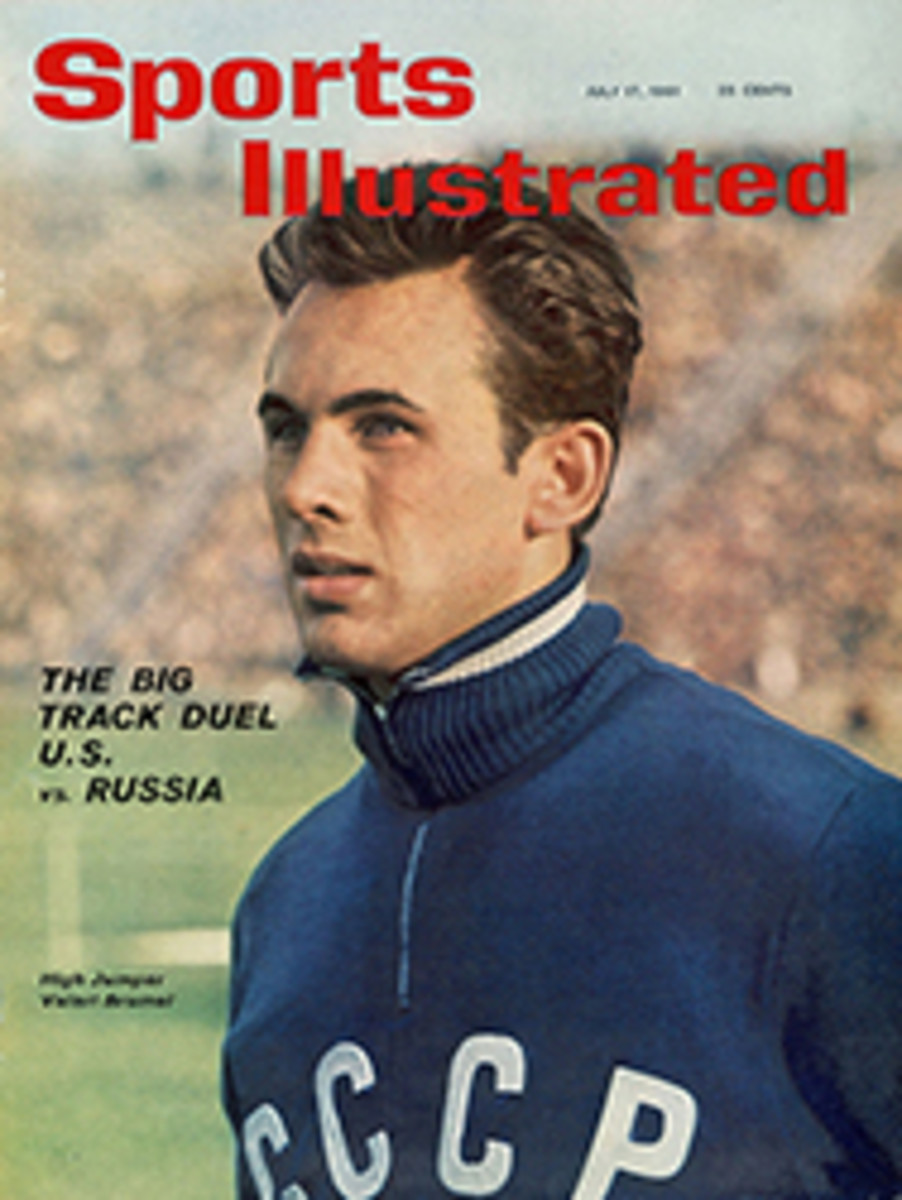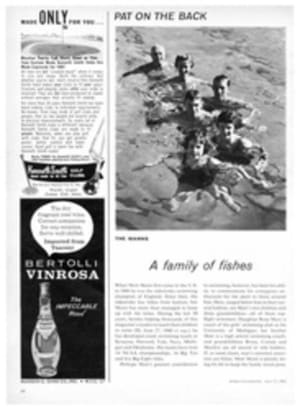
FIRST BLOOD FOR BUS
Off Oyster Bay on Long Island Sound last Saturday afternoon a starter's gun sounded, and three tall sloops, their bright Dacron sails filled by a light easterly breeze, glided across the starting line. The 12-meter boats were rehearsing the America's Cup drama again, warming up for the trials to decide who will defend next summer against a challenger from Australia.
By all the form charts, compiled from dozens of regattas, there should have been little doubt which of these three boats would win this early tune-up. The 69-foot Columbia, which took the trials in 1958 and then crushed Britain's Sceptre in four straight races, was the obvious favorite. Her archrival in 1958, the 22-year-old Vim, was shipped to Australia months ago under charter as a trial horse and crew-training ship for the syndicate behind the Australian challenge. And the two rivals that remained, Weatherly, with her 1958 skipper Arthur Knapp at the helm, and the mahogany-hulled Easterner, had spent most of their competitive existence in Columbia's, wake. Nevertheless, as the three boats hit the line, the eyes of the small spectator fleet were on Easterner, the craft that at Newport had won the nickname of the "If only..." boat.
Last boat to be launched in '58, sailed until the final few days by basically a family crew, and lacking the elaborate sail inventory and equipment of her competitors, Easterner did not win a single race during her entire first year of life. Although at times she proved herself capable of bursts of speed which impressed observers, something always happened before the finish. "If only..." said the experts: if only from the first she had had a crack crew, chosen and drilled with the unsentimental efficiency of a professional football team; if only she had had a wider selection of sails; if only she had had a top helmsman. But Chandler Hovey, her owner, a Boston investment banker, and at 78 the dean of active U.S. yachtsmen, had declared he would sail her as a "family boat," and so she remained during the entire summer. And suffered accordingly.
In the summers of 1959 and 1960, without the stimulus of a challenge, the 12-meter class was dormant except for an inconclusive series of match races between Weatherly and Easterner. But after the Australian challenge, Columbia, which had been on display in the marine museum in Mystic, Conn., was bought by Wall Street Broker Paul Shields, who appointed his brother, the internationally famous yachtsman Cornelius Shields, as chief strategist and adviser, and named Cornelius Jr. helmsman. Knapp called many of his old crew back aboard Weatherly.
But most important, Bus Mosbacher, the wizard who had kept the aging Vim in contention with Columbia in 1958, was invited to Boston and offered Easterner's helm. Moreover, he was said to be in complete control of tactics and crew, and to have been promised new sails and other necessary equipment.
Thus last week came the beginnings of the answer to Easterner's potential ability. After three spotty preliminary events, one not completed for lack of wind, Saturday, July 8 brought the three existing candidates together for the first important test in three years. I was aboard Easterner as she moved along in the light wind, which held remarkably steady and true throughout the course. The rival skippers all made good starts, on the line at the gun, but without the tactical fireworks that Mosbacher produced at Newport. After a series of tacks along the Connecticut shore, Easterner arrived at the first turning mark in third place, not moving as well as her adversaries in the light air, partially because she is the sort of boat that does best in heavy weather, but principally—in my opinion—because she did not have the proper jib.
At the mark, Columbia forced Weatherly to go about, then carried her wide, leaving an opening for Easterner at the buoy. Mosbacher drove through like Eddie Arcaro finding a hole at the rail. An efficient crew had a spinnaker up and drawing at the same instant, and Easterner simply sailed away from the other two 12s, downwind in light weather—not particularly her specialty on the basis of past performance.
It should have been the race, but wasn't—quite. At the second mark, Weatherly was some 300 yards astern, and Columbia completely out of the picture after an unsuccessful attempt to tack downwind. This time, for the beat back to the finish, Easterner set a different jib, but one that seemed no better than the first. Weatherly gained rapidly—so rapidly that before half of the leg was sailed she was abeam of Easterner. For a moment she moved ahead, and it seemed certain that she would go on to win. But the breeze freshened, and as it did, Easterner came alive. Weatherly dropped back and Knapp was forced to tack. Here again Bus Mosbacher showed perfect judgment and iron courage: it seemed doubtful that Easterner could reach the finish line without making a short tack—in this situation, a risky and perhaps disastrous maneuver. But Mosbacher felt he could make it. He held his course, and he was right. Easterner swept across with inches to spare, winner of the first three-boat event of her career, as well as her first formal race as a candidate for defense.
It was a good victory, truly won. But a long trail still lies ahead, and ultimate victory still depends on many factors, most of all on putting together the "little things"—the infinite details of equipment, crew and handling enumerated three years ago by Olin Stephens, designer of both Columbia and Vim. Under mutual agreement, for instance, the candidates are now being sailed with crews of 14, although only 11 may be aboard during the final trials and the defense. As of last weekend, except for Mosbacher and a few foredeck men picked by him, Easterner was still being sailed as a family boat. Aboard were four members of the Hovey clan—Chandlers senior and junior, son Charley and grandson Tommy—with others waiting ashore in depth. Sooner or later, a hard decision will have to be made. Furthermore, Easterner does not begin to match the sail selection of her rivals: not a single item has been added this year, while Columbia has a new mainsail, a new genoa and a new spinnaker to add to the fattest sail inventory with which a new skipper was ever blessed.
Meanwhile, what of the Australians? As of now, Sir Frank Packer, head of the Aussie syndicate, plans to launch his yet unnamed vessel in September and have her rigged and ready for sailing in December. Crew candidates are being drilled aboard Vim, the first 12-meter ever seen by the majority of the Australians. As soon as possible, trials and informal races will begin, to continue through our northern hemisphere winter. In the spring of next year, both boats will be shipped to New York, to proceed to Newport and a summer of practice while our own trials are taking place.
In every way the Australian challenge appears as thorough and well conceived as it is possible for a nation without any background in large racing classes to make. By copying the shape of Vim, Designer Alan Payne had the same departure point for tank testing as did Olin Stephens before the creation of Columbia. This should insure against a repetition of the Sceptre fiasco. With the consent of the New York Yacht Club, the challenging Royal Sydney Yacht Squadron was permitted use of the hull model testing facilities of the Stevens Institute in Hoboken, N.J., and rumor has it that tests were extensive. Now a team of Australian sailmakers is in the U.S. to purchase the necessary synthetic fabrics and study American methods.
Yet, I must confess believing that the number of "little things" the Australians must perfect will be almost out of reach on a first try. A finished 12-meter yacht requires a high degree of technological and scientific skills and a varied industrial background; there is knowledge of the behavior of synthetic materials that can only be acquired by experience, and the automatic reaction to certain competitive situations learned by practice from early youth.
Anyone for a defender?
But suppose the Australians do make the breakthrough and come up with a boat capable of beating the best we have in existence? Is the U.S. likely to put forward a defender more advanced than any of the three now sailing? So many rumors float around the 12-meter class that if they could be cashed in at $1 each, anyone could build a potential defender. But at this writing there does not seem to be a new boat in the offing. Henry Mercer, head of the syndicate owning Weatherly, verified one rumor when he admitted that if Weatherly failed to do well this summer, she might be replaced. Said Mr. Mercer, "If things don't pan out—and we are prepared to make all possible changes—we are definitely interested in the possibility of a new boat."
Beyond these rumors is the fact that Olin Stephens and Ray Hunt (who designed Easterner), have both worked up new drawings for a 12. Much tank testing has been done. But, though the naval architects are ready, customers with $400,000 to spend are lacking.
Would a new boat be faster than one of the old, say Columbia, the 17th defender? "Based on the results of the tank tests, we definitely feel the design could be improved," said Roderick Stephens, Olin's father. But time is running out. "The latest safe date for an order," says the elder Stephens, "would be right now, July, figuring forward from the completion of tank tests. Columbia was launched in June. It would still be possible to meet that schedule." Anyone who would like to defend had better step up right away.
PHOTO
TONY TRIOLO
WITH MOSBACHER AT THE WHEEL, AND COVEYS OF HOVEYS SWARMING AROUND THE COCKPIT, "EASTERNER" DRIVES AHEAD TO HER STARTLING VICTORY OFF OYSTER BAY
PHOTO
TONY TRIOLO
TRAILING 'EASTERNER' on spinnaker run, Weatherly crew trims sails for extra speed.
PHOTO
TONY TRIOLO
BUS MOSBACHER AT "EASTERNER" HELM
PHOTO
TONY TRIOLO
HUSTLING YOUNG CREW ON THE 1958 CUP CHAMPION "COLUMBIA" QUICKLY TAKES DOWN THE SPINNAKER AND PUTS UP A GENOA AS BOAT ROUNDS THE SECOND MARK
PHOTO
TONY TRIOLO
SEASONED CREW ABOARD "WEATHERLY" HANGS OVER WINDWARD RAIL ON WAY TO THE FIRST MARK. DESPITE SUCH ALL-OUT EFFORTS, "WEATHERLY" LOST IN FINAL LEG OF RACE

